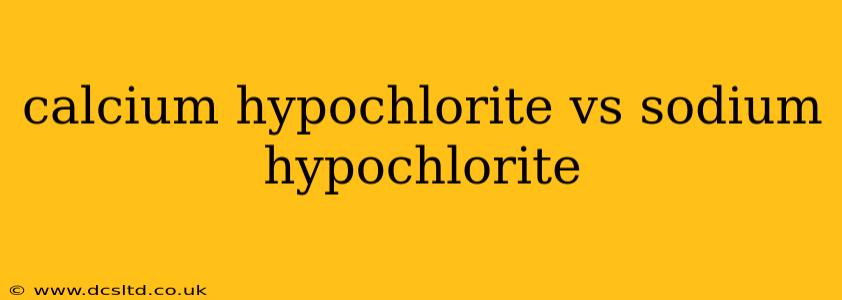Choosing between calcium hypochlorite and sodium hypochlorite for your disinfection needs can feel overwhelming. Both are powerful chlorine-based disinfectants, but they have key differences in their chemical composition, effectiveness, and applications. This comprehensive guide will delve into these differences, helping you make an informed decision based on your specific requirements.
What is Calcium Hypochlorite?
Calcium hypochlorite (Ca(ClO)₂) is a white crystalline powder commonly known as high-test hypochlorite (HTH). It contains a higher concentration of available chlorine (typically 65-73%) compared to sodium hypochlorite. This makes it a more potent disinfectant, requiring less product to achieve the same level of disinfection.
What is Sodium Hypochlorite?
Sodium hypochlorite (NaClO) is a liquid solution typically found as bleach. The concentration of available chlorine in household bleach is usually around 3-6%, while commercial-grade solutions can reach higher concentrations. Its lower chlorine concentration means more product is needed for effective disinfection.
Calcium Hypochlorite vs. Sodium Hypochlorite: Key Differences
| Feature | Calcium Hypochlorite (HTH) | Sodium Hypochlorite (Bleach) |
|---|---|---|
| Form | White crystalline powder | Liquid solution |
| Available Chlorine | Higher (65-73%) | Lower (3-6% household, higher for commercial grades) |
| Solubility | Less soluble in water; requires thorough mixing | Highly soluble in water |
| Stability | Less stable; can decompose over time, releasing chlorine | More stable, but can degrade with exposure to light and heat |
| Handling | Requires careful handling due to potential for dust inhalation and skin irritation | Easier to handle, but still requires appropriate precautions |
| Cost | Generally less expensive per unit of available chlorine | Generally more expensive per unit of available chlorine |
| Storage | Requires dry, cool, well-ventilated storage | Requires storage in opaque containers away from heat and light |
| Applications | Large-scale disinfection (pools, water treatment), sanitation | Household cleaning, smaller-scale disinfection, laundry |
What is the difference in terms of effectiveness?
Both are effective disinfectants when used correctly. Calcium hypochlorite, due to its higher available chlorine concentration, is often preferred for large-scale applications like swimming pool sanitation or water treatment where high disinfection power is needed. Sodium hypochlorite is suitable for smaller-scale disinfection tasks and household cleaning. Effectiveness depends on concentration, contact time, and the specific application.
Which is safer to use?
Both require careful handling. Calcium hypochlorite, as a powder, presents a greater risk of dust inhalation, which can irritate the lungs. Sodium hypochlorite solutions can cause skin and eye irritation. Always follow the manufacturer's instructions and wear appropriate protective gear when handling either chemical.
Which is better for swimming pools?
Calcium hypochlorite (HTH) is commonly used for swimming pools, especially in larger facilities, due to its high chlorine concentration and cost-effectiveness per unit of available chlorine. However, proper handling and application are crucial to avoid potential risks.
Which is better for household cleaning?
Sodium hypochlorite, commonly available as bleach, is better suited for household cleaning tasks. Its liquid form makes it easy to use and dilute for various cleaning applications, from laundry to disinfecting surfaces.
What are the environmental impacts?
Both calcium hypochlorite and sodium hypochlorite can have environmental impacts if not handled and disposed of properly. Chlorine released into water bodies can harm aquatic life. Appropriate disposal methods should be followed in accordance with local regulations.
Conclusion
The choice between calcium hypochlorite and sodium hypochlorite depends on your specific needs and the scale of the disinfection task. For large-scale applications requiring high disinfection power, calcium hypochlorite is often preferred. For household cleaning and smaller-scale disinfection, sodium hypochlorite is more convenient and readily available. Regardless of your choice, safe handling and proper disposal are paramount to ensure both human and environmental safety. Remember to always consult the manufacturer's safety data sheet (SDS) before using either product.
